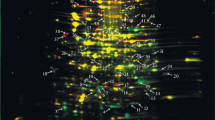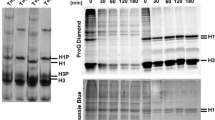Abstract
The addition of histone to the medium in the logarithmic phase of growth ofEscherichia coli influences alkaline phosphatase synthesis in two ways: it delays initiation of derepression of synthesis of the enzyme by about 60–80 min and it inhibits its synthesis. The inhibitory effect persists even after removing histone from the medium. In stationary-phase of growth the inhibitory effect of histone is obliterated. From an analysis of the initial kinetics of derepressed alkaline phosphatase synthesis and from previous results (Štrbáňová-Nečinováet al., 1972) it is concluded that histone added toEscherichia coli cells interferes with the synthesis of mRNA for alkaline phosphatase.
Similar content being viewed by others
References
Allfrey V. G., Littau V. C., Mirsky A. E.: On the role of histones in regulating ribonucleic acid synthesis in the cell nucleus.Proc. Nat. Acad. Sci. U.S. 49, 414 (1963).
Aoki T., Hnilica L. S., Griffin A. C.: The effect of histone fractions on liver catalase and tryptophan pyrrolase activites.Arch. Biochem. Biophys. 131, 538 (1969).
Barr G. C., Butler J. A. V.: Histones and gene function.Nature 199, 1170 (1963).
Bonner J., Huang R. C.: Histones as specific repressors of chromosomal RNA synthesis. Ciba Foundation Symp. on Histones, Churchill, London 1966, p. 18.
Bukrinskaya A. G., Burducea O., Gitelman A. K., Assadullaev T. A.: Additive effect of histones and actinomycin D on the cellular RNA synthesis.Exptl. Cell. Res. 42, 484 (1966).
Caffery J. M., Whichard L., Irvin J. L.: Induction of hepatic tryptophan pyrrolase and tyrosine transaminase by histones and other polypeptides.Biochim. Biophys. Acta 157, 616 (1968).
Cruft H. J.: Identification of histones in microorganisms. (General discussion) Ciba Foundation Symp. on Histones, Churchill, London 1966, p. 104.
Dick C.: Localization of histone fractions by radioautography.Experientia 24, 356 (1968).
Garen A., Levinthal C.: A fine structure genetics and chemical study of the enzyme alkaline phosphatase ofEscherichia coli. I. Purification and characterisation of alkaline phosphatase.Biochim. Biophys. Acta 38, 470 (1960).
Gilmour R. S., Paul J.: The nature of the specific restriction of template activity in chromatin of animal cells.Biochem. J. 104, 27P (1967).
Goodwin B. C., Sizer I. W.: Histone regulation of lactic dehydrogenase in embryonic chick brain tissue.Science 148, 242 (1965).
Hancock R., Amos H.: Nuclear binding of exogenous histones by L cells at low pH.J. Cell. Biol. 36, C1 (1968).
Hindley J.: The relative ability of reconstituted nucleohistones to allow DNA dependent RNA synthesis.Biochem. Biophys. Res. Commun. 12, 175 (1963).
Hnilica L. S., Bess L. G.: The heterogeneity of arginine-rich histones.Anal. Biochem. 12, 421 (1965).
Hnilica L. S., Hupka Š.: An improved procedure for the isolation of histone from calf thymus (In Slovak)Biológia 14, 821 (1959).
Horiuchi T., Horiuchi S., Nizuno D.: A possible negative feedback phenomenon controlling formation of alkaline phosphomonoesterase inEscherichia coli.Nature 183, 1529 (1959).
Huang R. C., Bonner J.: Histone, a suppressor of chromosomal ribonucleic acid (RNA) synthesis.Proc. Nat. Acad. Sci. U.S. 48, 1216 (1962)
Iwai K.: Nucleohistones, p. 59 in J. Bonner, P. Tso (Eds). Holden-Day, San Francisco 1964.
Kepes A.: Kinetics of induced enzyme synthesis. Determination of the mean life of galactosidase-specific messenger RNA.Biochim. Biophys. Acta 76, 293 (1963).
Kepes A., Beguin S.: Peptide chain initiation and growth in the induced synthesis of β-galactosidase.Biochim. Biophys. Acta 123, 546 (1966).
Lever J. L.: Ph. D. Thesis, Edinburgh University, 1964, cited by Cruft H. J. 1966. Identification of histones in microorganisms. (General discussion) Ciba Foundation Symp. on Histones, Churchill, London 1966, p. 104.
Malamy M., Horecker B. L.: The localization of alkaline phosphatase inEscherichia coli K12.Biochim. Biophys. Res. Commun. 5, 104 (1961).
Martin J. B., Doly D. H.: Determination of inorganic phosphate. Modification of isobutyl alcoho lprocedure.Ann. Chem. 21, 965 (1949).
Masnerová E.: Histone and its effect on protein synthesis inEscherichia coli studied in the alkaline phosphatasemodel. (In Czech).Thesis Faculty of Sciences, Charles University, Prague (1971).
Monod J., Cohen-Bazire O., Cohn M.: Sur la biosynthése de la β-galactosidase (lactase) chezEscherichia coli. La specificité de l'induction.Biochim. Biophys. Acta 7, 585 (1951).
Nečinová S., Stejskalová E., Pavlasová E.: The effect of histone on the inducible β-galactosidase ofEscherichia coli.Currents in Modern Biol. 1, 200 (1967).
Palmade C., Chevallier M. R., Knobloch A., Vendrely R.: Isolement d'une desoxyribonucléo-histone à partir d'Escherichia coli.Compt. Rend. 246, 2534 (1958).
Pavlasová E., Stejskalová E.: Transport of histone intoEscherichia coli cells.Folia Microbiol. 17, 471 (1972).
Reuter A. M., Gerber G. B.: Effect of histones on induction of tryptophan pyrrolase and tyrosine amino-transferase by hydrocortisone on isolated perfused rat liver. 6th FEBS Meeting, Madrid 1969. Abstract Book, p. 50.
Reuter A. M., Gerber G. B., Telia M.: Uptake of labelled histones by isolated perfused rat liver and by various organs of the intact mouse.Experientia 26, 496 (1970).
Sonnenberg B. P., Zubay C.: Nucleohistone as a primer for RNA synthesis.Proc. Nat. Acad. Sci. U.S. 54, 415 (1965).
Spelsberg T. C., Hnilica L. S.: Studies on the RNA polymerase histone complex.Biochim. Biophys. Acta 195, 55 (1969a).
Spelsberg T. C., Hnilica L. S.: The effects of acidic proteins and RNA on the histone inhibition of the DNA—dependent RNA synthesisin vitro.Biochim. Biophys. Acta 195, 63 (1969b).
Szabó G., Békési I., Vitális S.: Mode of action of factor C, a substance of regulatory functions in cytodifferentiation.Biochim. Biophys. Acta 145, 159 (1967).
Szeszák F., Szabo G., Sümegi J.: Examination of RNA synthesis on native DNA fraction fromStreptomyces griseus. 1st Internat. Symp. Genetics of Industrial Microorganisms, Prague 1970. Abstract Book, p. 244.
Svobodová O.: Study of physiological conditions for L-asparaginase synthesisE. Coli. (In Czech).Degree thesis Faculty of Sciences, Charles Uuiversity, Prague (1971).
Štrbáňová-Nečinová S., Stejskalová E., Pavlasová E.: Histone-induced changes of protein synthesis inEscherichia coli.Folia Microbiol. 17, 170 (1972).
Taketo A., Kuno S.: Accumulation of a “DNA-masking protein” inEscherichia coli under inhibitory conditions of DNA-synthesis.Biochim. J. 71, 497 (1972).
Tonino G. J. M., Rozijn Th. H.: On the occurrence of histones in yeast.Biochim. Biophys. Acta 124, 427 (1966).
Torriani A.: Influence of inorganic phosphate in the formation of phosphatase byEscherichia coli.Biochim. Biophys. Acta 38, 460 (1960).
Vorobyev V. J.: The effect of histones on RNA and protein synthesis in sea urchin embryos at early stages of development.Exptl. Cell. Res. 55, 168 (1969).
Waller J. P., Haris J. T.: Studies on the composition of the protein fromEscherichia coli ribosomes.Proc. Nat. Acad. Sci. U. S. 46, 18 (1961).
Yabuki H., Iwai K.: Changes of histone in the cell cycle of Tetrahymena.Biochim. J. 70, 731 (1971).
Yagil E., Silberstein N.: Decay of normal and 5-fluorouracil substituted messenger ribonucleic acid of alkaline phosphatase inEscherichia coli.J. Bacteriol. 100, 1364 (1969).
Author information
Authors and Affiliations
Additional information
Part I: Folia Microbiol.17, 170 (1972).
Rights and permissions
About this article
Cite this article
Masnerová, E., Štrbáňová-Nečinová, S. Histone-induced changes of protein synthesis inEscherichia coli . Folia Microbiol 18, 368–375 (1973). https://doi.org/10.1007/BF02875931
Received:
Issue Date:
DOI: https://doi.org/10.1007/BF02875931




